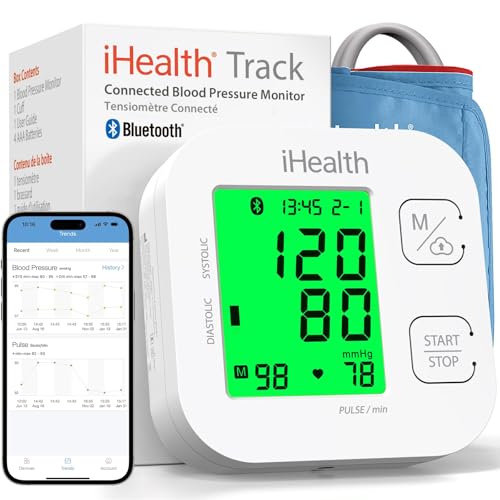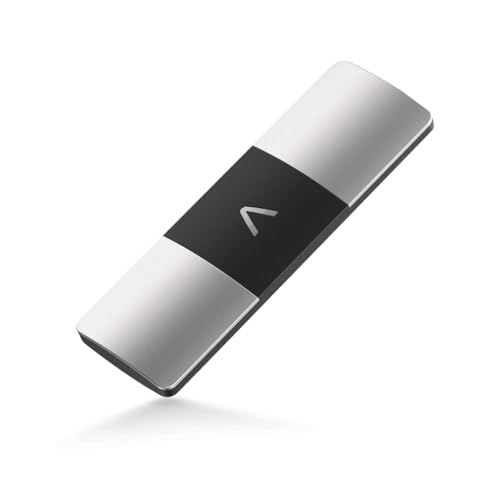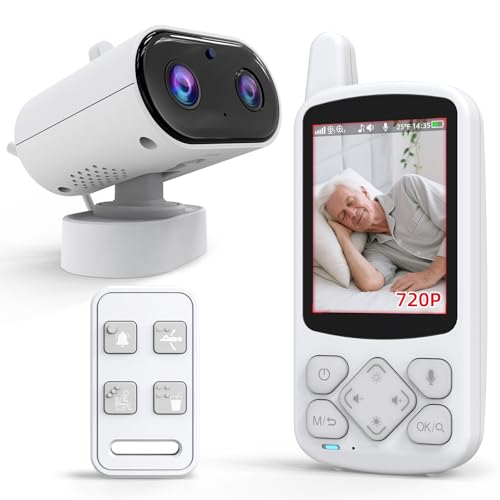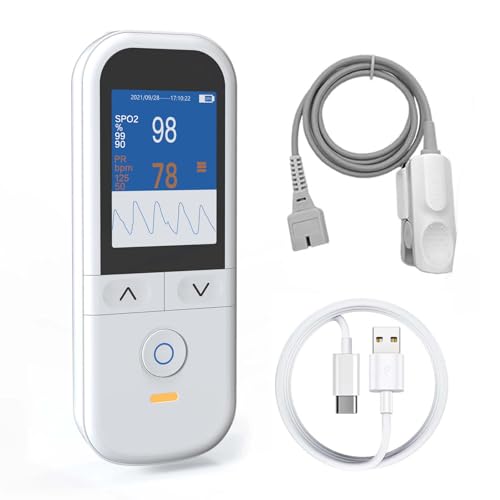In 2025, staying on top of your health has never been easier, thanks to the surge in handheld patient monitors. With options that blend cutting-edge technology and ease of use, you can track essential signs with confidence. Whether you need a compact EKG or a Bluetooth-enabled blood pressure monitor, there’s a device tailored for your needs. But how do you choose the right one? Let’s explore the top contenders that could enhance your portable health tracking experience.
CMI Health Rechargeable Pulse Oximeter for Adults
The CMI Health Rechargeable Pulse Oximeter is the perfect choice for adults seeking accurate and reliable monitoring of their blood oxygen levels. With its finger sensor, you can easily conduct continuous monitoring and spot-checks. This device adheres to professional standards, ensuring pulse rate accuracy of ±2 bpm and SpO2 accuracy of ±3% for saturation levels between 70-100%. It’s lightweight and features a 3-foot cable for added comfort. Plus, you’ll receive alerts if your levels drop below your set threshold. Enjoy peace of mind knowing you’re covered with a 1-year warranty for the device and a 6-month warranty for sensors.
Best For: Adults seeking a reliable and accurate method for monitoring blood oxygen levels at rest.
Pros:
- High accuracy: Pulse rate accuracy of ±2 bpm and SpO2 accuracy of ±3% for saturation levels 70-100%.
- Continuous monitoring: Durable sensor for long-term use with alert functions for safety.
- Convenient design: Lightweight with a 3-foot cable for ease of movement and cleaning.
Cons:
- Limited compatibility: Not designed for ear lobe or forehead sensors.
- Not suitable for active use: The device is not intended for monitoring during motion or activity.
- Shorter sensor warranty: 6-month warranty for sensors compared to a 1-year warranty for the device itself.
iHealth Track Smart Upper Arm Blood Pressure Monitor
For anyone seeking an affordable yet reliable way to monitor blood pressure at home, the iHealth Track Smart Upper Arm Blood Pressure Monitor stands out. Priced at about $39.99, it offers Bluetooth compatibility with both iOS and Android devices. The large, color-coded display makes reading results easy, while the device stores up to 99 readings. You’ll appreciate its heart rhythm detection feature, alerting you to any disturbances. Plus, the iHealth MyVitals app helps track trends and share data with your healthcare provider. While some users report minor Bluetooth issues, overall, it’s a solid choice for effective home monitoring.
Best For: Individuals seeking an affordable and user-friendly blood pressure monitor for home use.
Pros:
- Affordable price point at approximately $39.99.
- Large, easy-to-read color-coded display for quick results.
- Bluetooth compatibility with iOS and Android devices, along with app integration for tracking trends.
Cons:
- Accuracy may not be top-tier compared to higher-end models.
- Instruction manual may lack clarity for some users.
- Occasional Bluetooth syncing issues reported.
KardiaMobile 6-Lead Personal EKG Monitor
Offering six views of the heart, the KardiaMobile 6-Lead Personal EKG Monitor is an ideal choice for individuals seeking reliable, at-home heart health monitoring. It detects AFib, Bradycardia, and Tachycardia, providing instant results in just 30 seconds. This FDA-cleared device records medical-grade EKGs, ensuring you receive trusted, accurate data. Compatible with most smartphones and tablets, you can easily track your heart health by downloading the Kardia app. Best of all, there’s no subscription required to access your EKG readings, allowing you to monitor your heart rhythms without added costs. Stay proactive about your heart health with this innovative device!
Best For: Individuals seeking reliable, at-home heart health monitoring without the need for a subscription.
Pros:
- Provides six-lead EKG for a detailed view of heart activity.
- Instant results in just 30 seconds, offering quick insights into heart health.
- No subscription required for EKG readings, making it cost-effective.
Cons:
- Does not check for heart attacks, limiting its diagnostic capabilities.
- Requires smartphone compatibility and app download for functionality.
- May not be suitable for those without access to mobile devices or technology.
CallToU Elderly Monitor with Camera and Audio
Ideal for caregivers looking to keep a close eye on seniors, the CallToU Elderly Monitor with Camera and Audio combines essential features like real-time two-way communication and infrared night vision. This portable device doesn’t require Wi-Fi, making it perfect for home or nursing home use. With a pocket-sized 2.8-inch screen, you can easily monitor your loved ones from a distance. The 355° camera rotation and 4× zoom capability enhance visibility, while daily alerts help remind seniors about hydration and medication. Plus, the SOS button guarantees quick assistance in emergencies, making it a reliable choice for elderly care.
Best For: Caregivers seeking a reliable and easy-to-use monitoring solution for seniors, including those in nursing homes or with dementia.
Pros:
- Easy setup and portable design for convenient monitoring.
- Real-time two-way communication and infrared night vision for enhanced visibility.
- Daily alerts for hydration and medication reminders to support senior care.
Cons:
- Design may feel more suited for infant monitoring rather than elderly care.
- Some users have reported audio quality issues.
- Limited usability for seniors, impacting overall effectiveness.
Smart Caregiver Video Monitor for Elderly Care
The Smart Caregiver Video Monitor is an excellent choice for caregivers who need to keep a close eye on elderly loved ones, especially during nighttime hours. Its portable design, weighing just 12.3 ounces, guarantees easy mobility around the house. With infrared night vision and a rechargeable battery, you can monitor effectively without relying on WiFi. The two-way communication feature allows you to hear and speak to your loved ones. Plus, it alerts you if they try to get up, helping to prevent falls. Enjoy peace of mind with this user-friendly device that’s perfect for both elderly and post-operative care.
Best For: Caregivers needing a reliable and portable video monitoring solution for elderly loved ones, especially during nighttime.
Pros:
- High-definition image quality with infrared night vision for clear monitoring in low light.
- Portable and lightweight design with a rechargeable battery for easy mobility.
- Two-way communication feature allows caregivers to interact with loved ones directly.
Cons:
- Requires constant power for the camera, limiting mobility if not plugged in.
- Two-way communication could use improvements for clearer audio.
- Lacks WiFi connectivity, which may limit some remote monitoring options.
Medical Grade Pulse Oximeter for Adults
For families looking to monitor the health of elderly or pregnant members, the Medical Grade Pulse Oximeter for Adults stands out with its continuous SpO2 and heart rate monitoring capabilities. You can easily set personalized safe ranges, and the device will alert you with loud sounds for any abnormal readings. With the ability to store up to 500 data sets and 20-hour continuous monitoring logs, tracking health history becomes simple. Its 2.4-inch HD display and rechargeable USB-C design guarantee you have a reliable tool at your fingertips, making it perfect for daily and long-term health monitoring needs.
Best For: Families looking to monitor the health of elderly or pregnant members with reliable and continuous health monitoring.
Pros:
- Continuous monitoring of SpO2 and heart rate provides reliable health insights.
- Personalized safe range settings with loud alerts for abnormal readings enhance safety.
- Large HD display and rechargeable battery make it user-friendly and convenient for long-term use.
Cons:
- The device may require guidance for first-time users to set up properly.
- Limited battery life of 8 hours may necessitate frequent recharging during extended use.
- May not be suitable for children or individuals under specific medical conditions without physician guidance.
EKG Monitor Device, Personal Heart Rate Monitor with LCD Screen
Looking for a portable solution to monitor your heart health? The EKG Monitor Device is an excellent choice. This compact ECG monitor weighs just 60g and fits easily in your pocket. In only 30 seconds, it provides professional ECG data with multiple monitoring modes for accuracy. You can effortlessly connect it to your smartphone or computer via Bluetooth or cable, allowing you to share results with family or doctors. Its bright LCD screen displays reliable heart rate readings, giving you peace of mind. While some users report mixed experiences, many find it a valuable tool for personal health management.
Best For: Individuals seeking a portable and user-friendly solution for monitoring their heart health in real time.
Pros:
- Compact and lightweight design makes it easy to carry anywhere.
- Provides instant ECG results in just 30 seconds with multiple monitoring modes for accuracy.
- Compatible with smartphones and computers, allowing for easy data sharing with family or healthcare providers.
Cons:
- Some users have reported concerns about the accuracy and reliability compared to other monitoring devices.
- Mixed reviews regarding overall quality, with some finding it less trustworthy for professional medical use.
- Initial lack of iOS compatibility may have limited accessibility for some users.
EMAY 6L Portable ECG Monitor
With its ability to record ECG signals and display heart rates across six channels, the EMAY 6L Portable ECG Monitor is ideal for individuals seeking an accessible way to manage their heart health at home. You can easily connect it to your PC via USB or your mobile phone through Bluetooth, making data management a breeze. The software includes handy features like sample mode and case reviews. Plus, its built-in rechargeable lithium battery offers long-lasting power for your monitoring needs. Just remember, it’s not suitable for those with pacemakers and shouldn’t replace hospital diagnostic devices.
Best For: Individuals seeking a user-friendly and accessible solution for managing heart health at home.
Pros:
- Multi-channel Monitoring: Records ECG signals and displays heart rates in six channels for comprehensive heart health tracking.
- Flexible Connectivity: Easy connection to PCs via USB and mobile devices through Bluetooth for convenient data management.
- Long-lasting Power: Equipped with a rechargeable lithium battery that ensures extended usage without frequent recharging.
Cons:
- Not for Pacemaker Users: Not suitable for individuals with implanted pacemakers, limiting its user base.
- OTC Use Limitations: Designed for over-the-counter use, it cannot replace professional hospital diagnostic ECG devices.
- Potential Software Learning Curve: Users may need some time to familiarize themselves with the software features and functionalities.
Greater Goods Sphygmomanometer Blood Pressure Cuff for Home Use
The Greater Goods Sphygmomanometer Blood Pressure Cuff stands out as an ideal choice for home users and caregivers, especially those managing the health of elderly relatives. This latex-free manual cuff is designed for precision, providing reliable readings within ±3mmHg. Its integrated bulb and dial allow for one-handed operation, making it easy to use. With a large, easy-to-read dial and color-coded markings, you’ll quickly understand your results. Lightweight and portable, it fits adult upper arms and includes a compact carrying case. Plus, you can count on US-based support and a 2-year warranty for peace of mind.
Best For: Individuals managing their blood pressure at home, particularly caregivers and elderly users.
Pros:
- Clinically tested for accuracy, providing reliable readings within ±3mmHg.
- User-friendly design features an integrated bulb and large, easy-to-read dial for one-handed operation.
- Portable and convenient with a compact carrying case, ideal for home use and travel.
Cons:
- Some users report calibration issues, which may affect accuracy.
- Cuff may not fit heavier individuals comfortably due to size limitations.
- Occasional quality control problems have been noted regarding calibration consistency.
Veterinary Monitor for Pets (SpO2/TEMP/NIBP Monitoring)
Veterinary monitors designed for pets offer an essential solution for animal health professionals who need to track SpO2, TEMP, and NIBP in real-time. This compact, handheld device features a high-resolution 3.5″ color LCD that displays waveforms clearly. Weighing between 280g and 370g, it’s easy to handle during emergencies or routine checks. With customizable alarm limits and intuitive operation, monitoring becomes efficient. The rechargeable battery lasts over 24 hours, ensuring reliability. Its universal compatibility makes it suitable for various animals, while precision measurements cater to specific needs. User feedback highlights its utility, though some noted occasional technical challenges.
Best For: Animal health professionals, including veterinarians and clinics, who require reliable and precise monitoring of pets’ vital signs.
Pros:
- High-resolution 3.5″ color LCD provides clear real-time waveforms.
- Lightweight and compact design enhances portability for point-of-care use.
- Customizable alarm limits and adaptable monitoring modes improve workflow efficiency.
Cons:
- Some users reported technical issues after a few months of use.
- Difficulty in obtaining support or replacement products has been noted.
- Limited battery life in high-demand situations despite being over 24 hours on a single charge.
Factors to Consider When Choosing a Handheld Patient Monitor
When choosing a handheld patient monitor, you need to contemplate several key factors. Accuracy and reliability are essential, but you also shouldn’t overlook features like device compatibility and battery life. Portability and design can make a big difference in how effectively you use the monitor in various settings.
Accuracy and Reliability Standards
Choosing a handheld patient monitor requires careful consideration of accuracy and reliability standards, as these factors directly impact patient care. Look for devices that comply with essential medical standards like CE, ISO 9001, and ISO 13485, ensuring quality. Check the accuracy ratings for crucial sign measurements—pulse rate should typically be within ±2 bpm, and SpO2 levels should be ±3% for readings between 70-100%. Continuous monitoring devices must have alert systems to notify caregivers of abnormal readings, enhancing patient safety. Be cautious; stationary monitors aren’t reliable during motion. Finally, opt for devices that can store and retrieve historical data to track health trends over time, boosting the monitor’s overall reliability.
Monitoring Features and Functions
While evaluating handheld patient monitors, it’s crucial to focus on their monitoring features and functions, as these can greatly affect patient outcomes. Look for devices that offer continuous monitoring capabilities, especially for crucial signs like SpO2 and heart rate. This guarantees timely alerts for any abnormalities. Customizable alarm settings enhance patient safety by notifying you when readings fall outside established safe ranges. Additionally, the ability to store historical data and provide trends over time helps track health changes, aiding informed decisions. Confirm the device is user-friendly, with a clear display and straightforward operation for quick access to important metrics. Finally, consider devices compatible with mobile applications for seamless data sharing and improved communication with healthcare providers.
Device Compatibility and Connectivity
How well does your handheld patient monitor connect with other devices? Device compatibility is vital. Confirm your monitor works seamlessly with your smartphones, tablets, or computers for smooth data transfer and monitoring. Look for Bluetooth connectivity for easy pairing with mobile apps, which enhances your experience and enables remote health tracking. Consider the types of connections available, like USB or specialized cables, fundamental for data management and software integration. It’s also wise to check for multi-language support in the software, improving usability in diverse healthcare settings. Finally, verify the device’s software is regularly updated to maintain compatibility with new operating system versions on your connected devices. This way, you’ll stay connected and efficient in patient monitoring.
Battery Life and Charging
When selecting a handheld patient monitor, battery life and charging capabilities play a crucial role in your decision. Look for devices that offer battery life ranging from 8 to over 24 hours, depending on your needs. Rechargeable batteries are a smart choice, reducing both long-term costs and environmental impact. Fast charging is another feature to take into account, as it allows you to quickly power up the device between monitoring sessions. Also, pay attention to the type of charging interface, whether it’s USB-C or a proprietary connector, as this affects compatibility with your existing equipment. Some monitors include battery-saving modes, like VOX mode, which can further extend battery life during less intensive monitoring periods, ensuring your device lasts when you need it most.
Portability and Design
As you explore handheld patient monitors, portability and design are key factors that can greatly impact your experience. Look for lightweight, compact devices that are easy to transport and use in various settings. A user-friendly design with large, easy-to-read displays and intuitive interfaces makes it accessible for both healthcare professionals and patients. Battery life is essential, so opt for monitors with rechargeable batteries that offer extended operational time for reliability. Ergonomic designs enhance comfort, allowing you to hold the device longer without strain. Additionally, choose models that provide flexibility in monitoring capabilities, such as multiple sensors and customizable settings, to adapt effectively to different patient needs. These features will guarantee a smooth and efficient monitoring experience.
Safety Features and Alerts
Portability and user-friendly design are just the beginning when selecting a handheld patient monitor; safety features and alerts play a vital role in ensuring effective patient care. Look for customizable alarm limits that notify you when readings fall outside safe ranges, allowing for timely intervention. Loud sound alerts are essential for patients needing immediate attention, such as those with low SpO2 or abnormal heart rates. Continuous monitoring helps detect prolonged abnormal readings, with some devices alerting you if levels remain off for an extended period. A durable, easy-to-clean design aids in preventing cross-contamination, significant in healthcare settings. Some monitors even offer mute functions, silencing alerts during non-critical times while ensuring notifications resume when necessary.
Data Management Capabilities
Selecting a handheld patient monitor involves more than just portability; data management capabilities are vital for effective patient care. Look for devices that can store a substantial amount of historical data—some can hold up to 500 data sets, allowing for thorough tracking of a patient’s health over time. Easy access to these historical readings is critical for identifying trends and changes in conditions. Multi-language support enhances usability for diverse user populations. Continuous monitoring logs, lasting up to 20 hours, enable extended tracking of health metrics. Finally, customizable alarm settings for abnormal readings can facilitate proactive health management and timely interventions, ensuring you’re always prepared to respond to patient needs effectively.
Intended Use and Limitations
When evaluating handheld patient monitors, understanding their intended use and limitations is key to effective patient care. These devices are designed for specific functions like measuring heart rate, blood pressure, or oxygen saturation, but they often lack the extensive capabilities of full-scale hospital equipment. Choose a monitor that fits your needs—whether for continuous clinical monitoring or occasional home use. Be mindful of limitations; some monitors aren’t suitable for use during physical activity or may only work on specific body parts, like finger sensors for pulse oximeters. Pay attention to accuracy specifications, as variations can affect readings. Remember, these monitors aren’t substitutes for professional medical equipment and should complement your healthcare provider’s recommendations, especially for individuals with specific health conditions.









